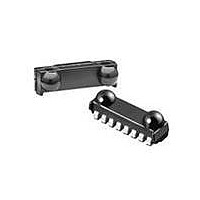TFDU6300-TT3 Vishay, TFDU6300-TT3 Datasheet - Page 6

TFDU6300-TT3
Manufacturer Part Number
TFDU6300-TT3
Description
Special-Purpose Opto Device,Bar-1b
Manufacturer
Vishay
Datasheet
1.TFDU6300-TT3.pdf
(12 pages)
Specifications of TFDU6300-TT3
Wavelength
886 nm
Continual Data Transmission
4 Mbit/s
Radiant Intensity
180 mW/sr
Half Intensity Angle Degrees
48 deg
Pulse Width
2.2 us
Maximum Rise Time
40 ns
Maximum Fall Time
40 ns
Operating Voltage
2.4 V to 3.6 V
Maximum Operating Temperature
+ 85 C
Minimum Operating Temperature
- 25 C
Dimensions
8.5 mm x 3.1 mm x 2.5 mm
Data Rate
4Mbs (FIR)
Idle Current, Typ @ 25° C
1.8 mA
Link Range, Low Power
70cm
Operating Temperature
-25°C ~ 85°C
Orientation
Top View
Shutdown
*
Size
8.5mm x 3.1mm x 2.5mm
Standards
IrPHY 1.4
Supply Voltage
2.4 V ~ 3.6 V
Lead Free Status / RoHS Status
Lead free / RoHS Compliant
Lead Free Status / RoHS Status
Lead free / RoHS Compliant
TFDU6300
Vishay Semiconductors
RECOMMENDED CIRCUIT DIAGRAM
Operated at a clean low impedance power supply the
TFDU6300 needs no additional external components.
However, depending on the entire system design and board
layout,
(see figure 3).
The capacitor C1 is buffering the supply voltage and
eliminates the inductance of the power supply line. This one
should be a tantalum or other fast capacitor to guarantee the
fast rise time of the IRED current. The resistor R1 is only
necessary for high operating voltages and elevated
temperatures.
Vishay transceivers integrate a sensitive receiver and a
built-in power driver. The combination of both needs a
careful circuit board layout. The use of thin, long, resistive
and inductive wiring should be avoided. The inputs (TXD,
SD) and the output RXD should be directly (DC) coupled to
I/O AND SOFTWARE
In the description, already different I/Os are mentioned.
Different combinations are tested and the function verified
with the special drivers available from the I/O suppliers. In
special cases refer to the I/O manual, the Vishay application
notes, or contact directly Vishay Sales, Marketing or
Application.
MODE SWITCHING
The TFDU6300 is in the SIR mode after power on as a
default mode, therefore the FIR data transfer rate has to be
set by a programming sequence using the TXD and SD
inputs as described below. The low frequency mode covers
speeds up to 115.2 kbit/s. Signals with higher data rates
should be detected in the high frequency mode. Lower
frequency data can also be received in the high frequency
mode but with reduced sensitivity. To switch the transceivers
from low frequency mode to the high frequency mode and
vice versa, the programming sequences described below are
required.
www.vishay.com
6
TABLE 1 - RECOMMENDED APPLICATION CIRCUIT COMPONENTS
COMPONENT
C1
C2
R1
R2
19307
V
V
GND
SD
TXD
RXD
additional
CC2
CC1
Fig. 3 - Recommended Application Circuit
C1
No resistor necessary, the internal controller is able to
irdasupportAM@vishay.com, irdasupportAP@vishay.com,
components
R1
R2
For technical questions within your region, please contact one of the following:
C2
RECOMMENDED VALUE
control the current
SD
TXD
RXD
IRED Cathode
may
IRED Anode
V
Ground
0.1 µF, ceramic
Fast Infrared Transceiver Module (FIR, 4 Mbit/s)
10 , 0.125 W
CC
4.7 µF, 16 V
be
required
for 2.4 V to 3.6 V Operation
the I/O circuit.
The capacitor C2 combined with the resistor R2 is the low
pass filter for smoothing the supply voltage.
R2, C1 and C2 are optional and dependent on the quality of
the supply voltages V
power supply with dropping voltage during transmission may
reduce the sensitivity (and transmission range) of the
transceiver.
The placement of these parts is critical. It is strongly
recommended to position C2 as close as possible to the
transceiver power supply pins. A tantalum capacitor should
be used for C1 while a ceramic capacitor is used for C2.
In addition, when connecting the described circuit to the
power supply, low impedance wiring should be used.
When extended wiring is used the inductance of the power
supply can cause dynamically a voltage drop at V
some power supplies are not able to follow the fast current
rise time. In that case another 4.7 µF (type, see table under
C1) at V
Keep in mind that basic RF-design rules for circuit design
should be taken into account. Especially longer signal lines
should not be used without termination. See e.g. “The Art of
Electronics” Paul Horowitz, Winfield Hill, 1989, Cambridge
University Press, ISBN: 0521370957.
SETTING TO THE HIGH BANDWIDTH MODE
(0.576 Mbit/s to 4 Mbit/s)
1. Set SD input to logic “high”.
2. Set TXD input to logic “high”. Wait t
3. Set SD to logic “low” (this negative edge latches state of
4. After waiting t
TXD is now enabled as normal TXD input for the high
bandwidth mode.
TXD, which determines speed setting).
hold time of TXD is limited by the maximum allowed pulse
length.
irdasupportEU@vishay.com
CC2
will be helpful.
h
200 ns TXD can be set to logic “low”. The
CRCW-1206-10R0-F-RT1
VISHAY PART NUMBER
VJ 1206 Y 104 J XXMT
CCx
293D 475X9 016B
and injected noise. An unstable
Document Number: 84763
s
200 ns.
Rev. 2.0, 04-Aug-09
CC2
. Often













